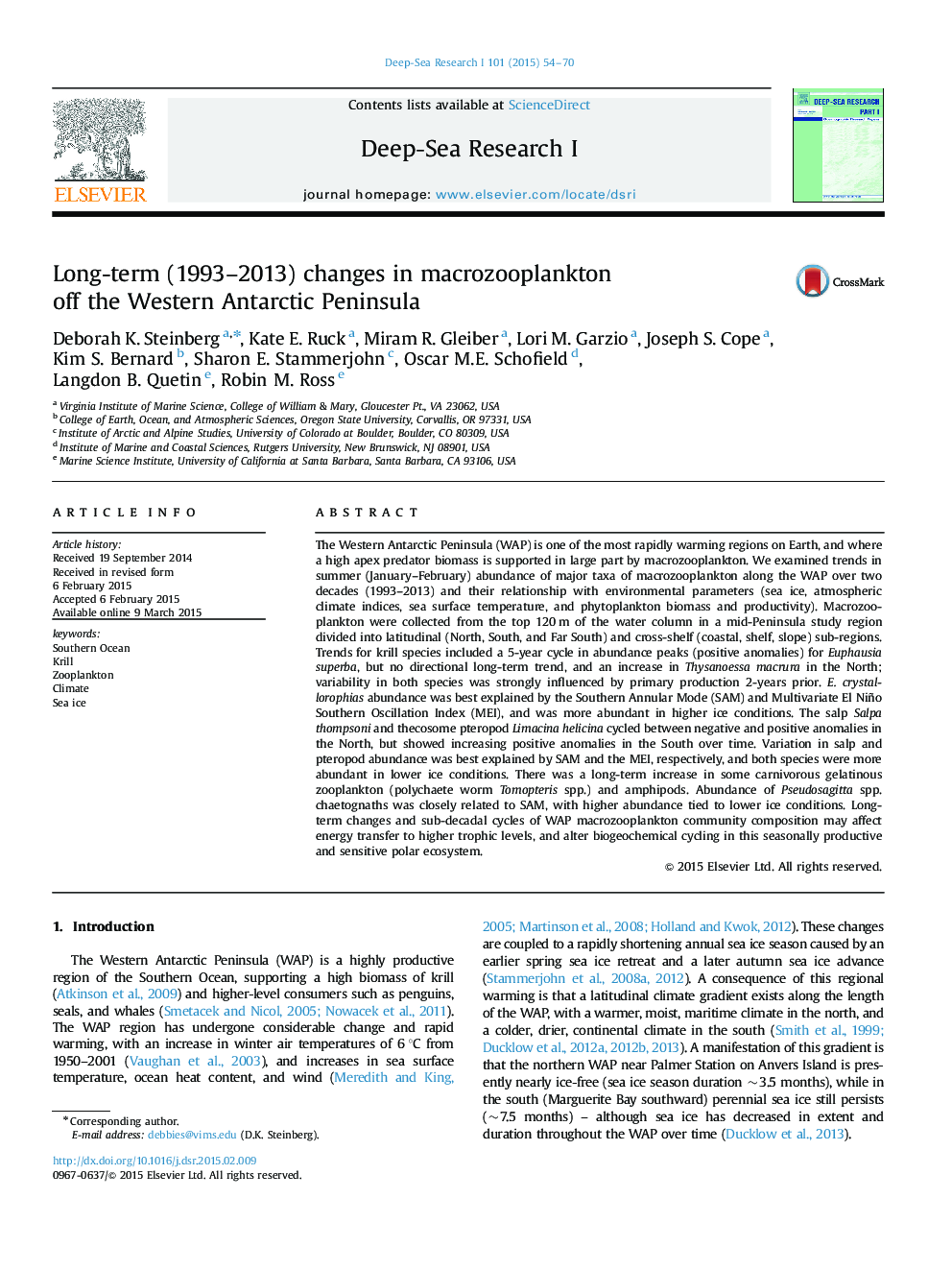| کد مقاله | کد نشریه | سال انتشار | مقاله انگلیسی | نسخه تمام متن |
|---|---|---|---|---|
| 6383523 | 1626329 | 2015 | 17 صفحه PDF | دانلود رایگان |
عنوان انگلیسی مقاله ISI
Long-term (1993-2013) changes in macrozooplankton off the Western Antarctic Peninsula
دانلود مقاله + سفارش ترجمه
دانلود مقاله ISI انگلیسی
رایگان برای ایرانیان
کلمات کلیدی
موضوعات مرتبط
مهندسی و علوم پایه
علوم زمین و سیارات
زمین شناسی
پیش نمایش صفحه اول مقاله

چکیده انگلیسی
The Western Antarctic Peninsula (WAP) is one of the most rapidly warming regions on Earth, and where a high apex predator biomass is supported in large part by macrozooplankton. We examined trends in summer (January-February) abundance of major taxa of macrozooplankton along the WAP over two decades (1993-2013) and their relationship with environmental parameters (sea ice, atmospheric climate indices, sea surface temperature, and phytoplankton biomass and productivity). Macrozooplankton were collected from the top 120Â m of the water column in a mid-Peninsula study region divided into latitudinal (North, South, and Far South) and cross-shelf (coastal, shelf, slope) sub-regions. Trends for krill species included a 5-year cycle in abundance peaks (positive anomalies) for Euphausia superba, but no directional long-term trend, and an increase in Thysanoessa macrura in the North; variability in both species was strongly influenced by primary production 2-years prior. E. crystallorophias abundance was best explained by the Southern Annular Mode (SAM) and Multivariate El Niño Southern Oscillation Index (MEI), and was more abundant in higher ice conditions. The salp Salpa thompsoni and thecosome pteropod Limacina helicina cycled between negative and positive anomalies in the North, but showed increasing positive anomalies in the South over time. Variation in salp and pteropod abundance was best explained by SAM and the MEI, respectively, and both species were more abundant in lower ice conditions. There was a long-term increase in some carnivorous gelatinous zooplankton (polychaete worm Tomopteris spp.) and amphipods. Abundance of Pseudosagitta spp. chaetognaths was closely related to SAM, with higher abundance tied to lower ice conditions. Long-term changes and sub-decadal cycles of WAP macrozooplankton community composition may affect energy transfer to higher trophic levels, and alter biogeochemical cycling in this seasonally productive and sensitive polar ecosystem.
ناشر
Database: Elsevier - ScienceDirect (ساینس دایرکت)
Journal: Deep Sea Research Part I: Oceanographic Research Papers - Volume 101, July 2015, Pages 54-70
Journal: Deep Sea Research Part I: Oceanographic Research Papers - Volume 101, July 2015, Pages 54-70
نویسندگان
Deborah K. Steinberg, Kate E. Ruck, Miram R. Gleiber, Lori M. Garzio, Joseph S. Cope, Kim S. Bernard, Sharon E. Stammerjohn, Oscar M.E. Schofield, Langdon B. Quetin, Robin M. Ross,